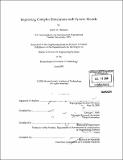| dc.contributor.advisor | George L. Roth and Deborah J. Nightingale. | en_US |
| dc.contributor.author | Hemann, Justin M. (Justin Matthew) | en_US |
| dc.contributor.other | Massachusetts Institute of Technology. Engineering Systems Division. | en_US |
| dc.date.accessioned | 2007-01-10T16:48:46Z | |
| dc.date.available | 2007-01-10T16:48:46Z | |
| dc.date.copyright | 2005 | en_US |
| dc.date.issued | 2005 | en_US |
| dc.identifier.uri | http://hdl.handle.net/1721.1/35615 | |
| dc.description | Thesis (S.M.)--Massachusetts Institute of Technology, Engineering Systems Division, 2005. | en_US |
| dc.description | Includes bibliographical references (leaves 96-98). | en_US |
| dc.description.abstract | Air Force sustainment operations are the focus of an intensive internal effort to improve performance and reduce costs. Past improvement initiatives have often failed to produce the intended results, and have caused performance to decline in some cases. Exploratory research was conducted at an Air Logistics Center to study how improvements are executed. Two conclusions are drawn from this research. The first is that changing sustainment operations is a problem of high dynamic and behavioral complexity. The second conclusion is that system models are well suited to coordinating change at the ALC because they provide insight into how a complicated system can be managed and improved. Three key findings support these conclusions. First, there is significant correlation between categories of unavailable F-16 aircraft such that reductions in one category are associated with increases in another. Second, an analysis of change efforts in two parts of the ALC shows that systemic influences, such as the inability to reinvest in improvements, are hindering change initiatives in one part of the ALC. | en_US |
| dc.description.abstract | (cont.) The third finding is that a model of sustainment operations suggests that independent improvement initiatives are outperformed by coordinated efforts driven with an understanding of systemic interactions. Leaders throughout the sustainment community have expressed their desire to understand how sustainment operations function as a system. A hybrid approach to change is offered as a method for understanding and improving sustainment operations. System models are used to quantify and model system interactions; then policies and recommendations are drawn from the models. Recommendations may include process-level improvements utilizing change methods already in use at the ALC. | en_US |
| dc.description.statementofresponsibility | by Justin M. Hemann. | en_US |
| dc.format.extent | 98 leaves | en_US |
| dc.format.extent | 4613647 bytes | |
| dc.format.extent | 4904209 bytes | |
| dc.format.mimetype | application/pdf | |
| dc.format.mimetype | application/pdf | |
| dc.language.iso | eng | en_US |
| dc.publisher | Massachusetts Institute of Technology | en_US |
| dc.rights | M.I.T. theses are protected by copyright. They may be viewed from this source for any purpose, but reproduction or distribution in any format is prohibited without written permission. See provided URL for inquiries about permission. | en_US |
| dc.rights.uri | http://dspace.mit.edu/handle/1721.1/7582 | |
| dc.subject | Engineering Systems Division. | en_US |
| dc.title | Improving complex enterprises with system models | en_US |
| dc.type | Thesis | en_US |
| dc.description.degree | S.M. | en_US |
| dc.contributor.department | Massachusetts Institute of Technology. Engineering Systems Division | |
| dc.identifier.oclc | 75960173 | en_US |
